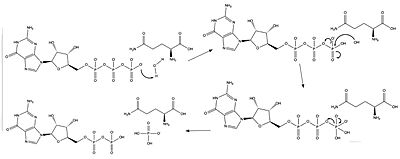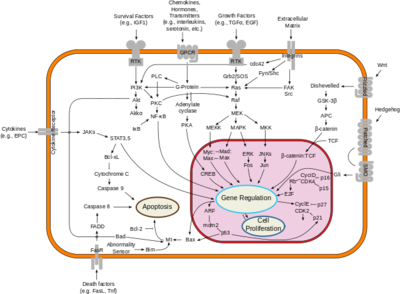Introduction
Neurofibromin is a cytoplasmic protein located close to the cell membrane that is encoded by the NF1 gene located on chromosome 17 [1]. It is a suppressor of the Ras oncogene through its effect on the rate of catalysis from Ras-GTP (active) to Ras-GDP (inactive)[2]. NF increasing the rate of catalysis of Ras means that Ras spends more time in its inactive state and cannot cause unnecessary cell proliferation linked to cancer[3].
Structure
Domains
GRD domain
SEC-PH
CSRD and CTD
Important Structural Features
Active Site
Arginine Finger
Conformations
RAS Complex
Mechanism of Ras Coupled with Neurofibromin
The RasGAP interactions that occur when neurofibromin's GAP domain and Ras are bound have two critical catalytic components. The first is the of the NF protein, which stabilizes the catalytic glutamine, as well as stabilizing the transition state of the phosphoryl transfer[4]. The second component is the catalytic glutamine of the Ras protein, which stabilizes the nucleophilic water as it attacks the third phosphate group in the GTP molecule as shown in Figure 1[5].

Figure 1: The catalytic glutamine stabilizes the nucleophilic water.
Downstream Effects
Disease Relevance
Mutations to the neurofibromin protein are implicated in the progression of Neurofibromatosis type 1 (NF1). This condition drives several forms of human cancers by inactivating the Ras suppression effects of NF, allowing Ras to behave as an oncogene. Neurofibromatosis type 1 is an autosomal dominant disorder that affects 1 in 3,000 people, and the NF gene itself has the highest mutation rate of any known human gene, adding to its prevalence[6]. NF1 primarily causes tumors in the central and peripheral nervous systems, but often has a multisystem expression including tumors in the dermatologic, cardiovascular, gastrointestinal, and orthopedic systems[7]. The wide range of presentations is consistent with the multiplicity of mutations observed in the causative protein[8].
This is a sample scene created with SAT to by Group, and another to make of the protein. You can make your own scenes on SAT starting from scratch or loading and editing one of these sample scenes.


